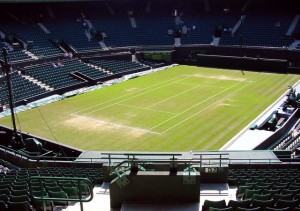Wimbledon. It’s one of those one words spoken in the English language and you know exactly what it is and what it represents – the ultimate in tennis, elegance, grace, tradition. Bud Collins, the world’s most famous tennis journalist and historian, summarizes the grandest tennis tournament in the world in this excerpt from his famed tennis encyclopedia called THE BUD COLLINS HISTORY OF TENNIS ($35.95, New Chapter Press, available here: http://ow.ly/5laMo
This is the Grand-daddy, first-born of all tournaments in the game of lawn tennis as we know it. It was 130-years-old in 2007, having hopefully entered the sporting world in 1877 and became the cynosure of the game. Considered the championships of Great Britain, the tournament is officially entitled The Lawn Tennis Championships. But one word—Wimbledon—is quite sufficient, proclaiming the majesty of it all, referring to location, the suburb of that name in southwest London.

Since the beginning, it has been conducted on the grounds of the All England Lawn Tennis and Croquet Club (1868), first at the Worple Road site, then to its present setting on Church Road in 1922. Last week in June-first week in July have been the dates for more than a century.
The first Centre Court seated about 4,000, grounds capacity 7,500. The present Centre, seating 9,989 in its 1922 debut, has held as many as 16,000, standing liberally permitted. But current law, eliminating standing, limits it to 13,802 seats. A new No. 1 Court (1997) seats 11,429. Intimate Court No. 2—the so-called “Graveyard of Champions”— held 1,900, losing its shape in a 2009 re-modeling.
Record one-day attendance on the grounds was 42,457, the first Wednesday of 2002. The tourney record for the fortnight (13 daytime sessions; no play on the middle Sunday) was 476,711 in 2001. (Overall, the record is 490,081 in 2001 when inclement weather made a 14th day necessary.) Estimates of the peak years at Worple Road range between 60,000 and 70,000. Rain, seemingly a constant antagonist, was at its worst in 1922, daily downpours pushing the conclusion to the third Wednesday. A retractable roof for Centre is to be in use by 2009.
Tennis was first played at the Club in 1875 and pretty much took over from the croquet-eers in 1882. A gathering of 200, paying about 20 cents apiece, witnessed two locals, among 22 entrants, jousting for the inaugural title, won by 27-year-old Spencer Gore, 6-1, 6-2, 6-4, over William Marshall, 28. Only 30 of the spectators were seated. Seven years later, in an intramural English clash, Maud Watson, 19, beat her 26-year-old sister, Lillian Watson, 6-8, 6-3, 6-3, and the women had their initial champ. Thirteen had entered.
The surface has always been God’s own sod: grass. The challenge round system was in force for men’s singles (1878 through 1921), women’s singles (1885 through 1921) and men’s doubles (1885 through 1921). It meant that the defending champion played only one match the following year, waiting for a challenger to emerge from the all-comers tournament. When the champion chose not to defend, the winner of the all-comers was the new champ.
In 1972, two years after the U.S. introduced the tie-breaker, Wimbledon accepted the novelty, but cautiously at 8-8 in games, not 6-6, and not the American “sudden death” style. But in 1979, Wimbledon conformed with the rest of the world at 6-6, and continued with the “lingering” ITF version, best-of-12-points, but a margin of two points required. However, the tie-breaker is not applied to ultimate sets, the fifth for men, third for women. Deuce sets, eliminating 6-5 set scores, were adopted in 1884, as were byes later than the first round.
Wimbledon had lobbied for “Open” tournaments, and welcomed pros and amateurs together in 1968, allotting $63,000 as prize money. Rod Laver got $4,800 as first prize, Billie Jean King $1,800. As the last major to offer equal prize money for men and women, the tournament in 2007 paid champs Roger Federer and Venus Williams $1.4 million apiece from of a pot of over $22.5 million. They also got to keep smaller replicas of the trophies: for men, the Challenge Cup engraved “The All England Lawn Tennis Club Single Handed Championship of the World” along with names of the champions; for women, the Rosewater Dish, engraved with names of the champions.
Unluckily for the natives, none has embraced these baubles since Virginia Wade in 1977 and Fred Perry in 1936.
